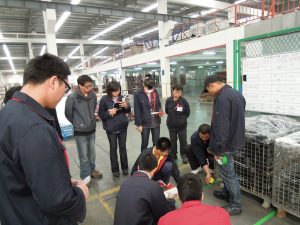by Tim McLean and Justin Tao

One of the first things that westerners learn about Asian culture, especially Chinese and North Asian culture is importance of keeping face. Public embarrassment or humiliation, which is what it means to lose face, is something people in any culture try to avoid, but in China and North Asia it is an absolute imperative to keep face. The more senior you are the more important it is to keep face and the easier it is to loose it. In many ways this is a very positive cultural value. It means that people will work hard to live up to commitments they have made and keep their word. However to create a true lean continuous improvement culture sometimes you need to be prepared to loose face. This means accepting and embracing problems and failings in your organisation. It also means listening to junior staff when they highlight problems or deficiencies in your business and it means admitting when you are wrong or when you do not know the answer.
The Problems with always Maintaining Face
One big difference we notice working in Asia, compared to working in the West is that in Asian factories we rarely get the chance to work with operators. By contrast, in Australia we often achieve change by getting the operators enthusiastic and engaging their ideas and experience. This is because, in a factory, the operators are the people who actually add value for the customer. By taking on their ideas to improve the factory performance increases, motivation increases and the managers achieve their targets – so everyone wins. In China we generally need to work through managers and supervisors to make change. It is a much more top down approach and I think this is a shame and often means a missed opportunity.
People in any society come from vastly different backgrounds, have different levels of drive and ambition, value different things and are experience different opportunities. As a result smart people can be found at every level of an organisation, from the most junior operator to the CEO’s office. We also know that the person who is usually the best expert on a particular job is the person who does that job, because they do the job every day and experience the problems. This applies whether they are performing open-heart surgery or packing parts in a box. The implication of this is that there is knowledge at every level of your organisation that can help improve your performance and bottom line. The role of managers in a lean organisation is therefore not to be the experts on how to solve every problem or opportunity, but to empower people to identify and solve these problems. The key principles of lean leadership are go see, ask why and show respect. Lean leadership is therefore about developing mutual trust and respect, not showing a leader’s power.
We sometimes run in to problems with face, because there is a fear on the part of the Supervisor that if the operators can find problems and make improvements then the Manager will think the Supervisor is not doing his job. Therefore the operators will often not say anything about the problems they see and improvement opportunities and the business will suffer. This tendency to hide problems is a huge problem in Asia (witness the consequences of the cover-ups after the Fukushima Nuclear Meltdowns in Japan). Changing this requires a different approach from managers. We say that when faced with problems managers need to go from the “Five Who’s” to the “Five Why’s”. Rather than asking who made the mistake and who should be punished, the manager should ask why the problem occurred and what is the root cause and how we can learn from the mistake to prevent it occurring again. This approach gives focus on the work (process) and on the problems to solve, avoiding the chase for guilty; Also It keeps the responsibility (ownership, authority) with who is performing the job.
The successful supervisor is the one who engages his operators and encourages them to raise and help solve problems and capitalise on opportunities. This will mean that this supervisor will have a lot of problems in his area. In fact we encourage teams to raise and solve lots of problems – we call it solving problems every day.
No Problem is a Problem
If we find there are no problems in a production process or department this should raise alarm bells for us. This means that problems are being hidden, or that inventory buffers, long cycle times and excessive lead time are allowing problems to be fixed without being noticed. When we create lean flow we reduce the waste between processes and soon find problems with issues such as rework, variable cycle time, machine reliability, operator skills and material supply. By finding the problems we then have an opportunity to fix them, whereas when problems are hidden the business will keep paying for them.
How to Change the Culture
We do not suggest changing Asia culture, but we do suggest that incentives and attitudes can be changed so that what a Supervisor needs to do to “maintain face” does not stand in the way of communication and effective improvement. Therefore supervisors should be praised not criticised for highlighting a lot of problems in their area and for encouraging their team to do the same. This shows that they know what is going on in their area are actively looking for ways to improve. They should be supported to work with their teams to solve the problems themselves rather than just passing them on to Managers or Engineers to solve. Operators should be rewarded for good ideas and for highlighting problems, particularly when they relate to quality, safety or reliability.
On the other hand a supervisor that says everything is perfect and he has no problems needs to be challenged to find some problems! He needs to demonstrate that he is talking to his team about what their problems are and where improvement can be made. Perhaps production targets for the “problem free” department need to be increased and inventory reduced to expose the hidden problems. Supervisors who are not comfortable with allowing their team to speak about their issues in front of managers need to be coached and encouraged to change their behaviour.
Face can also be Used as a Lever to Create Change.
As I said at the start, the concept of face has many positive aspects. One thing we find in China is enthusiasm that teams have to “be the best”. Therefore if one team is seen to be successful through implementing lean, then the other teams will want to compete and catch up so that they do not loose face when compared to the lean team. This means that once the initial improvement breakthrough occurs, you can achieve rapid improvement if you provide the right encouragement and foster a spirit of friendly competition.
A Final Word for Western Readers
As I mentioned at the start, the concept of “maintaining face” is a core Asian cultural value and can be a very positive influence in life and business in Asia. In writing my suggestions above I think it is still very important that the concept of face is respected. There is a saying that “An Englishman’s Home is His Castle”, in my experience in Asia, the workplace can be a “Castle” as well. I have seen western managers and lean experts bluntly criticise the Chinese Factories to the factory owner in front of his team. This is a very unsuccessful approach. Criticism needs to be given positively in the context of making something good better rather than just talking about what is bad. The efforts of managers and the team as individuals need to be recognised even if the results may not meet the standard needed right now. While this may seem counter-intuitive to westerners who are used to being very blunt in their criticism, the consequence of failing to respect a person’s face is that you will not be respected yourself. Then, even if you are making valid criticisms and comments, they will be seen as the views of someone who is disrespectful and not respected and therefore unlikely to be acted on
I have even heard western managers say that face is a silly concept and should be ignored. These individuals are effectively saying that showing respect to other cultures and other people is not important and I suggest these individuals are best to stay in their own countries.
Summary
So to summarise, maintaining face is important and worthwhile and westerners should respect this. However to be successful in lean and continuous improvement Asian managers need to redefine face to encourage people at all levels in their businesses to raise and solve problems. Managers who seek to maintain face by having “no problems” may be the biggest barrier to your business improving its performance and bottom line.





